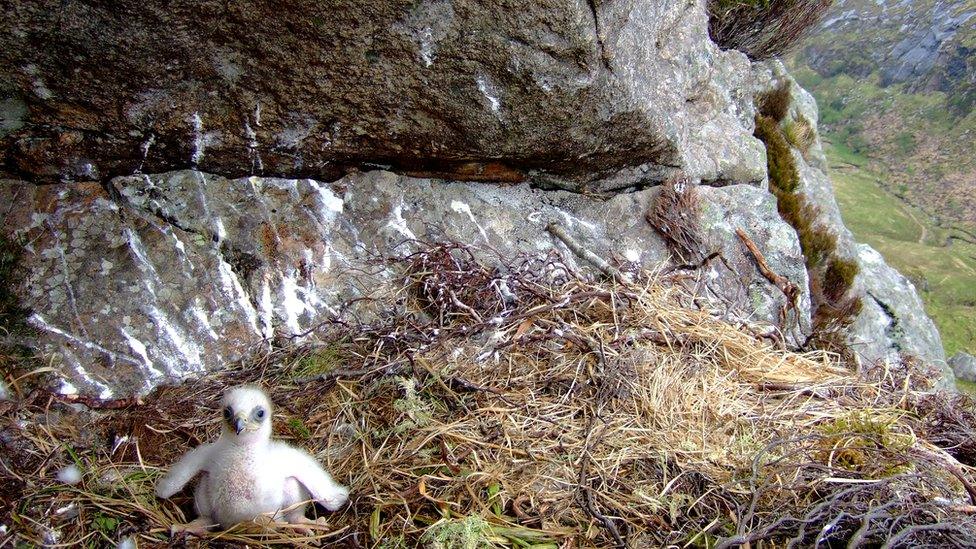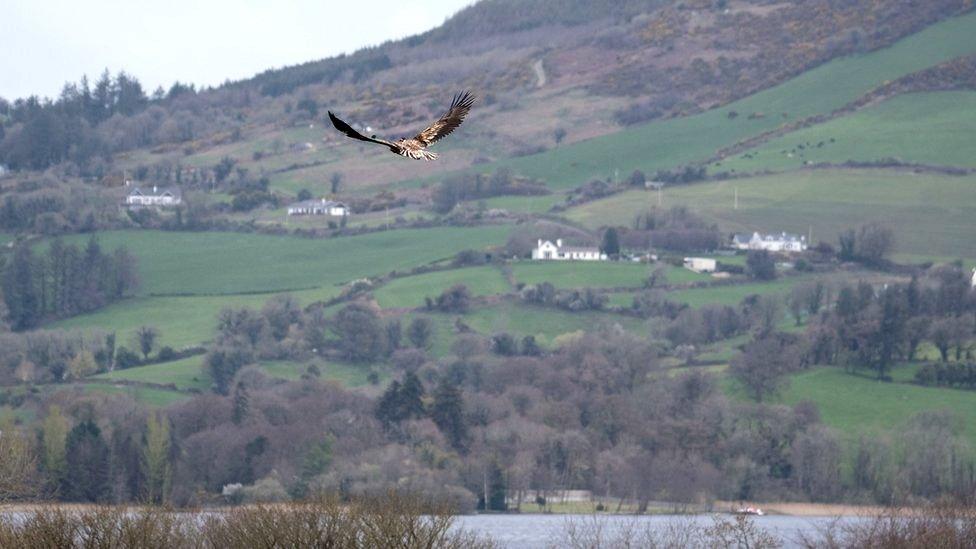Can Ireland's golden and white-tailed eagles continue to soar?
- Published

About 20 to 25 golden eagles are currently believed to be in Donegal
Two decades after being reintroduced to Ireland, two majestic eagle species are still battling to establish themselves.
Both golden and white-tailed eagles were once widespread on the island, but both species have been extinct in the Republic of Ireland since the early 20th Century.
While a pair of golden eagles nested in County Antrim in the late 1950s, none are currently known to be nesting in Northern Ireland.
The reasons that led to extinction in the Republic may be mostly a thing of the past, but experts say the birds still face many challenges in terms of repopulation.
These include poisonings, storms, bird flu and even wind turbines.
Despite this, those behind the reintroduction projects in the Republic of Ireland remain cautiously optimistic that they will succeed.
The first of the schemes to get off the ground was the golden eagle project.
In 2001, the Golden Eagle Trust brought its first chick from Scotland to Glenveagh National Park in County Donegal.
Between then and 2012, 63 Scottish-bred golden eagles were released in the county.

Irish-bred golden eagles have been fledged in County Donegal

A golden eagle nest in the mountains of Donegal
"Since then we've had 21, 22 chicks fledge in Donegal," says Lorcán O'Toole, of the Golden Eagle Trust.
He says a key early priority was to talk to sheep farmers in the area and reassure them about the eagles.
"When we approached them in 2000 they were quite nervous, but we had good discussions with them and they spoke to the Scottish National Farmers' Union and were reassured by farmers themselves, their own peers, that golden eagles aren't an issue in terms of lambing," Mr O'Toole adds.
"That made a huge impact.
"I would liaise with farmers regularly now and there hasn't been an issue in over 20 years.
"In fact, I know several farmers who say they actually like to see the golden eagles, because they keep the grey crow numbers down and grey crows can be problematic at lambing time."

The Golden Eagle Trust consulted with farmers ahead of the project
Mr O'Toole says the project changed people's mindset about birds of prey and helped create a better understanding of the food chain.
"In terms of the golden eagle itself, we've done OK," he says.
"The golden eagle population is still kind of confined to Donegal and it should really have spread by now into Mayo or Galway. I think that will still happen.
"They're never going to be widespread, we might have eight or nine territories in Donegal, that's not a large number of birds, we're talking maybe 20 or 25 birds living in the county at this moment in time."
While the golden eagle paved the way, an even bigger eagle - with a 2.2m wingspan - has followed.
Between 2007 and 2011, 100 white-tailed eagle chicks were brought from Norway and released into Killarney National Park in County Kerry.
A further 31 chicks were released in the south west of Ireland in the last two years, with more releases planned this year and in 2023.
"We've now got 34 wild-born chicks added to the population of those brought to Ireland," the original project manager Dr Allan Mee, who is still an advisor, says.
'Just all wings'
Dr Mee says one of the first breeding pairs nested on an island in Lough Derg, just in front of the town of Mountshannon in County Clare.
"In 2014 we installed a proper viewing facility from Clare County Council and in three months we got over 10,000 people," he says.
"People are amazed by the size of the birds, they're often described as a kind of flying barn door, they look like they're just all wings.
"So people when they see them - we're not used to seeing big birds of prey in Ireland - they're just blown away by them."
He says they've had birds go as far as Westry and the Orkney Islands in the north of Scotland, and return.
"We had a bird that spent the whole summer in 2019 in the north of England and visited the Isle of Man on the way back to Ireland, the first white-tailed eagle seen there since 1930, that was an Irish wild-bred chick from Connemara."
Dr Mee says in the early days of the project a lot of birds were lost to poisoning, which also caused the deaths of many golden eagles.
Poison bait left out by farmers for crows and foxes was often eaten by the eagles, leading to a ban on the activity in 2010.

The birds have established an Irish-bred population in the south west of the island
"The eagles were high profile, so that was a major factor in the banning of the poisons, so it's a good result for all wildlife really," Dr Mee says.
Three birds have been lost in collisions with wind turbines, and in 2018 a further three were lost to bird flu, adds Dr Mee.
"White-tailed eagles are amongst the most vulnerable to bird flu among birds of prey because they prey on water birds that carry the bird flu."
Storm Hannah in 2019 also caused losses as it struck when chicks were in nests.

Conservation ranger Clare Heardman with Sunniva, an eagle chick raised by her mother after her father disappeared
Philip Buckley, of the National Parks and Wildlife Service, explains why the second wave of reintroductions was necessary.
"The species had established a small, self-sustaining breeding population in Ireland so at that level it was certainly working," he says.
"And then we were looking at how many have survived and we went back and did this modelling again and the answer was the project was working, but if you want to guarantee its success you should think about a second reintroduction."
He said all the newer birds had satellite tags so they could be more closely monitored.
"If a tag shows the bird hasn't moved for a day or two, we might send out one of the rangers to have a look and see if it's got a problem," he says.
"Often the bird is fine, occasionally the bird is dead, at least once we found one that had been injured - it had lead poisoning and that bird was taken into care and recovered."

The eagles are tagged so their movements can be monitored
Clare Heardman is a conservation ranger in County Cork's Beara Peninsula, which has had two pairs of white-tailed eagles take residence over the years.
In 2020 they were able to set up a camera overlooking one of the nests and later discovered the male had disappeared.
The rangers intervened to help the mother bird feed its chick.
"She was able to fledge that chick so she was the first eagle single parent to fledge a chick in Ireland," she says.
"When we tagged that chick she was 6.8kgs which gives you an idea of their size."
Ms Heardman says many of the area's farmers were initially anxious, but that had been replaced by pride in some cases.
"The farmers might send me a text and say 'I saw the eagles today, I think herself is sitting on eggs'," she says.
"One of the farmers can remember his grandfather talking about the last eagles or hearing stories of them.
"So I think there's a little bit of pride that 'they chose to come back and settle in my valley'."

Dr Allan Mee says the goal is to get to the point where no more new birds have to be brought in
Dr Mee says the goal is to get to the point where no more new birds have to be brought in.
"We're near that point, so that's why we decided to bring some more birds in when we got the chance," he says.
"But I have no doubt they will, within the next two years, re-establish themselves."

The project aims to have white-tailed eagles spread out across Ireland
While no eagles are known to be nesting in Northern Ireland, the two projects in the Republic, as well as a golden eagle project in the south of Scotland, means that may come soon.
Mr O'Toole says some of the Donegal golden eagles "have shown some interest in County Antrim, the Antrim Glens, and around the Sperrins [in County Tyrone]".
"That south of Scotland project will be very important from a Northern Ireland perspective, because I do feel golden eagles will come over into Antrim," he says.
"And if those birds come in, it's up to the communities where they might settle, if they have any apprehensions, they could communicate with farmers in Scotland."

Lorcán O'Toole said some of the Donegal golden eagles have "shown an interest" in parts of Northern Ireland
Mr Buckley says in time, white-tailed eagles should start to breed in more areas of Ireland.
"We think that by expanding the release sites we increase the range of the species and maybe increase it a bit more quickly," he says.
"The whole intention is that this species will become widespread again throughout the island of Ireland."
Niall Hatch of Birdwatch Ireland says the projects "have shown that there is a clear appetite to have these birds back into the island of Ireland and that's a very good thing".
"We look forward to seeing these species spread and hopefully see more birds of prey reintroduced and naturally recovering and taking their rightful place in Ireland's skies.
"Their population here in Ireland is very low compared to Britain or the continent of Europe, and if we are to redress that, this is a very good way to start the process."